Here are the research highlights from the current issue of Development:
Nodal regulates germ cell potency
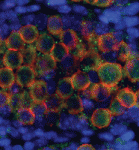 During mammalian gonadal development, somatic cues regulate the sex-specific development of foetal germ cells and control the transition between proliferation and cell-fate commitment. This transition is particularly important for male germ cells: too little proliferation reduces sperm numbers and fertility, whereas escape from commitment and prolonged pluripotency can cause testicular germ cell tumours. Now, Josephine Bowles, Peter Koopman and colleagues (p. 4123) report that the TGFβ morphogen Nodal regulates this transition in mice. The researchers show that Nodal signalling is active in XY germ cells at the developmental stage when this transition occurs and that Nodal signalling is triggered when somatic signals, including FGF9, induce testicular germ cells to upregulate the Nodal co-receptor Cripto. Genetic suppression of Nodal signalling leads to depressed pluripotency marker expression and early XY germ cell differentiation, they report, whereas NODAL and CRIPTO are upregulated in human testicular tumours. These results indicate that Nodal signalling regulates male germ cell potency during normal development and provides new clues about the aetiology of testicular cancer.
During mammalian gonadal development, somatic cues regulate the sex-specific development of foetal germ cells and control the transition between proliferation and cell-fate commitment. This transition is particularly important for male germ cells: too little proliferation reduces sperm numbers and fertility, whereas escape from commitment and prolonged pluripotency can cause testicular germ cell tumours. Now, Josephine Bowles, Peter Koopman and colleagues (p. 4123) report that the TGFβ morphogen Nodal regulates this transition in mice. The researchers show that Nodal signalling is active in XY germ cells at the developmental stage when this transition occurs and that Nodal signalling is triggered when somatic signals, including FGF9, induce testicular germ cells to upregulate the Nodal co-receptor Cripto. Genetic suppression of Nodal signalling leads to depressed pluripotency marker expression and early XY germ cell differentiation, they report, whereas NODAL and CRIPTO are upregulated in human testicular tumours. These results indicate that Nodal signalling regulates male germ cell potency during normal development and provides new clues about the aetiology of testicular cancer.
Cardiomyocyte migration mends broken hearts
 Unlike adult mammals, adult zebrafish can regenerate injured heart tissue. Heart regeneration in zebrafish is known to involve partial de-differentiation and proliferation of cardiomyocytes, but are cardiomyocytes involved in any other processes during heart repair? Here (p. 4133), Yasuhiko Kawakami and co-workers report that cardiomyocyte migration to the injury site is required for zebrafish heart regeneration. Ventricular amputation, they report, induces expression of the chemokine ligand cxcl12a and the chemokine receptor cxcr4b in epicardial tissue and cardiomyocytes, respectively. Both pharmacological inhibition of Cxcr4 function and genetic loss of cxcr4b function prevent heart regeneration, they show, and lead to mislocalisation of proliferating cardiomyocytes outside the injury site without affecting cardiomyocyte proliferation. Finally, the researchers use a photoconvertible fluorescent marker to show that, although cardiomyocytes migrate into the injury site in control hearts, their migration is inhibited in Cxcr4-antagonist-treated hearts. Thus, cardiomyocyte migration into injured zebrafish heart tissue is regulated independently of cardiomyocyte proliferation, and coordination of both processes is essential for heart regeneration.
Unlike adult mammals, adult zebrafish can regenerate injured heart tissue. Heart regeneration in zebrafish is known to involve partial de-differentiation and proliferation of cardiomyocytes, but are cardiomyocytes involved in any other processes during heart repair? Here (p. 4133), Yasuhiko Kawakami and co-workers report that cardiomyocyte migration to the injury site is required for zebrafish heart regeneration. Ventricular amputation, they report, induces expression of the chemokine ligand cxcl12a and the chemokine receptor cxcr4b in epicardial tissue and cardiomyocytes, respectively. Both pharmacological inhibition of Cxcr4 function and genetic loss of cxcr4b function prevent heart regeneration, they show, and lead to mislocalisation of proliferating cardiomyocytes outside the injury site without affecting cardiomyocyte proliferation. Finally, the researchers use a photoconvertible fluorescent marker to show that, although cardiomyocytes migrate into the injury site in control hearts, their migration is inhibited in Cxcr4-antagonist-treated hearts. Thus, cardiomyocyte migration into injured zebrafish heart tissue is regulated independently of cardiomyocyte proliferation, and coordination of both processes is essential for heart regeneration.
Hox genes specify nephric ducts
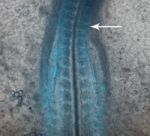 In amniote embryos, three kidneys – the pronephros (a transient embryonic structure), the mesonephros (the embryonic kidney) and the metanephros (the adult kidney) – form sequentially along the anterior-posterior (AP) axis of the intermediate mesoderm (IM). Here (p. 4143), Thomas Schultheiss and colleagues investigate AP patterning in the mesoderm by analysing the specification of the avian embryonic nephric duct – an unbranched epithelial tube that originates in the anterior IM. Using quail-chick chimaeric embryos, the researchers show that nephric duct specification occurs early in development when IM precursor cells are still in the primitive streak. HoxB4, they report, is expressed in nephric duct precursors from the primitive streak stage onwards, whereas the more posterior Hox gene HoxA6 is expressed in non-duct IM. Notably, misexpression of HoxA6 in the duct-forming regions of the IM represses duct formation. Together, these results indicate that Hox genes regulate AP patterning in the IM and provide new insights into general mesodermal patterning along the AP axis and into kidney evolution.
In amniote embryos, three kidneys – the pronephros (a transient embryonic structure), the mesonephros (the embryonic kidney) and the metanephros (the adult kidney) – form sequentially along the anterior-posterior (AP) axis of the intermediate mesoderm (IM). Here (p. 4143), Thomas Schultheiss and colleagues investigate AP patterning in the mesoderm by analysing the specification of the avian embryonic nephric duct – an unbranched epithelial tube that originates in the anterior IM. Using quail-chick chimaeric embryos, the researchers show that nephric duct specification occurs early in development when IM precursor cells are still in the primitive streak. HoxB4, they report, is expressed in nephric duct precursors from the primitive streak stage onwards, whereas the more posterior Hox gene HoxA6 is expressed in non-duct IM. Notably, misexpression of HoxA6 in the duct-forming regions of the IM represses duct formation. Together, these results indicate that Hox genes regulate AP patterning in the IM and provide new insights into general mesodermal patterning along the AP axis and into kidney evolution.
Cohesin quells Polycomb group silencing
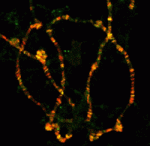 Polycomb group (PcG) genes encode transcriptional repressors that regulate gene expression during development. Most PcG genes encode subunits of chromatin-modifying complexes, but exactly how PcG proteins repress transcription is unclear. Now, Judith Kassis and colleagues report that Wapl, a cohesin-associated protein involved in cohesin removal from chromosomes, promotes PcG silencing in Drosophila (p. 4172). To identify genes involved in PcG silencing, the researchers conduct a screen for suppressors of silencing mediated by an engrailed PcG response element. They identify one of the suppressors obtained from this screen as waplAG, a dominant wapl mutation that produces a truncated Wapl protein. The researchers show that waplAG hemizygotes die as pharate adults (insects prior to emergence from pupae) but have an extra-sex-comb phenotype similar to that produced by mutations in PcG genes. Finally, the researchers show that Wapl-AG increases the stability of cohesin binding to polytene chromosomes. Together, these results suggest that increasing cohesin stability can interfere with PcG silencing, and that cohesin thus directly inhibits PcG function.
Polycomb group (PcG) genes encode transcriptional repressors that regulate gene expression during development. Most PcG genes encode subunits of chromatin-modifying complexes, but exactly how PcG proteins repress transcription is unclear. Now, Judith Kassis and colleagues report that Wapl, a cohesin-associated protein involved in cohesin removal from chromosomes, promotes PcG silencing in Drosophila (p. 4172). To identify genes involved in PcG silencing, the researchers conduct a screen for suppressors of silencing mediated by an engrailed PcG response element. They identify one of the suppressors obtained from this screen as waplAG, a dominant wapl mutation that produces a truncated Wapl protein. The researchers show that waplAG hemizygotes die as pharate adults (insects prior to emergence from pupae) but have an extra-sex-comb phenotype similar to that produced by mutations in PcG genes. Finally, the researchers show that Wapl-AG increases the stability of cohesin binding to polytene chromosomes. Together, these results suggest that increasing cohesin stability can interfere with PcG silencing, and that cohesin thus directly inhibits PcG function.
Human skin innate immunity develops early
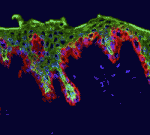 The skin protects the body from microbial pathogens by employing Toll-like receptors (TLRs) and other molecules that recognise pathogen-associated molecular patterns to initiate innate immune responses and to direct subsequent adaptive immunity. But when does the innate immune system in human skin become immunologically competent? On p. 4210, Adelheid Elbe-Bürger and co-workers answer this question by analysing TLR expression and function in human skin. The researchers report that, although prenatal and adult skin express a similar spectrum of TLRs, prenatal, infant and child skin express higher levels of several TLRs (particularly TLR3) than adult skin. Moreover, a synthetic TLR3 ligand that mimics viral double-stranded RNA significantly enhances the secretion of several chemokines and cytokines by keratinocytes isolated from foetal and neonatal donors but not by those isolated from adult donors. Thus, the researchers conclude, human skin exhibits age-related changes in TLR expression and function, and foetal keratinocytes are already endowed with specific immune functions that may protect the developing human body from viral infections.
The skin protects the body from microbial pathogens by employing Toll-like receptors (TLRs) and other molecules that recognise pathogen-associated molecular patterns to initiate innate immune responses and to direct subsequent adaptive immunity. But when does the innate immune system in human skin become immunologically competent? On p. 4210, Adelheid Elbe-Bürger and co-workers answer this question by analysing TLR expression and function in human skin. The researchers report that, although prenatal and adult skin express a similar spectrum of TLRs, prenatal, infant and child skin express higher levels of several TLRs (particularly TLR3) than adult skin. Moreover, a synthetic TLR3 ligand that mimics viral double-stranded RNA significantly enhances the secretion of several chemokines and cytokines by keratinocytes isolated from foetal and neonatal donors but not by those isolated from adult donors. Thus, the researchers conclude, human skin exhibits age-related changes in TLR expression and function, and foetal keratinocytes are already endowed with specific immune functions that may protect the developing human body from viral infections.
Calcium crosstalk during plant fertilisation
 During sexual reproduction in flowering plants, cellular interactions guide the growth of the pollen tube from the stigma to the embryo sac where fertilisation occurs. The cytoplasmic Ca2+ concentration ([Ca2+]cyt) regulates pollen tube growth, but does it also regulate pollen tube guidance and reception? On p. 4202, Seiji Takayama and colleagues investigate Ca2+ dynamics during fertilisation by expressing a Ca2+ sensor in Arabidopsis pollen tubes and synergid cells (cells in the ovule that guide the pollen tube). During semi-in vivo fertilisation, they report, pollen tubes turn towards wild-type ovules but not towards ovules in which pollen tube guidance has been genetically disrupted. Notably, [Ca2+]cyt is higher in turning pollen tube tips than in non-turning tips. Moreover, [Ca2+]cyt oscillation in the synergid cells, which reaches a maximum at pollen tube rupture, begins only upon pollen tube arrival. These results suggest that signals from the synergid cells induce Ca2+ oscillations in the pollen tube and vice versa, and that these oscillations are involved in pollen tube guidance and reception.
During sexual reproduction in flowering plants, cellular interactions guide the growth of the pollen tube from the stigma to the embryo sac where fertilisation occurs. The cytoplasmic Ca2+ concentration ([Ca2+]cyt) regulates pollen tube growth, but does it also regulate pollen tube guidance and reception? On p. 4202, Seiji Takayama and colleagues investigate Ca2+ dynamics during fertilisation by expressing a Ca2+ sensor in Arabidopsis pollen tubes and synergid cells (cells in the ovule that guide the pollen tube). During semi-in vivo fertilisation, they report, pollen tubes turn towards wild-type ovules but not towards ovules in which pollen tube guidance has been genetically disrupted. Notably, [Ca2+]cyt is higher in turning pollen tube tips than in non-turning tips. Moreover, [Ca2+]cyt oscillation in the synergid cells, which reaches a maximum at pollen tube rupture, begins only upon pollen tube arrival. These results suggest that signals from the synergid cells induce Ca2+ oscillations in the pollen tube and vice versa, and that these oscillations are involved in pollen tube guidance and reception.
Plus…
The year 2012 marks 25 years since the journal Development was relaunched from its predecessor, the Journal of Embryology and Experimental Morphology (JEEM). To mark a quarter century of Development, we have been looking through our archives at some of the most influential papers published in Development’s pages. In a series of ‘Development Classic’ articles, we have asked the authors of those articles to tell us the back-story behind their work and how the paper has influenced the development of their field. The first two of these articles (see below) are published in this issue – look out for more of these Spotlight papers in the next few issues.
The ABC model of flower development: then and now
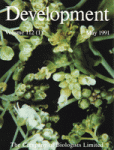 In 1991, John Bowman, David Smyth and Elliot Meyerowitz published a paper in Development that proposed the ABC model of flower development. Now, the authors look back on their paper and discuss several aspects of this story.
In 1991, John Bowman, David Smyth and Elliot Meyerowitz published a paper in Development that proposed the ABC model of flower development. Now, the authors look back on their paper and discuss several aspects of this story.
See the Spotlight article on p. 4095
The zebrafish issue of Development
 In December 1996, in a special issue of Development, 37 papers reported the results of two large screens for zebrafish mutants performed in Tübingen and Boston. Now, Christiane Nüsslein-Volhard gives a personal account of the history of this unique endeavor.
In December 1996, in a special issue of Development, 37 papers reported the results of two large screens for zebrafish mutants performed in Tübingen and Boston. Now, Christiane Nüsslein-Volhard gives a personal account of the history of this unique endeavor.
See the Spotlight article on p. 4099
Eph/ephrin signalling during development
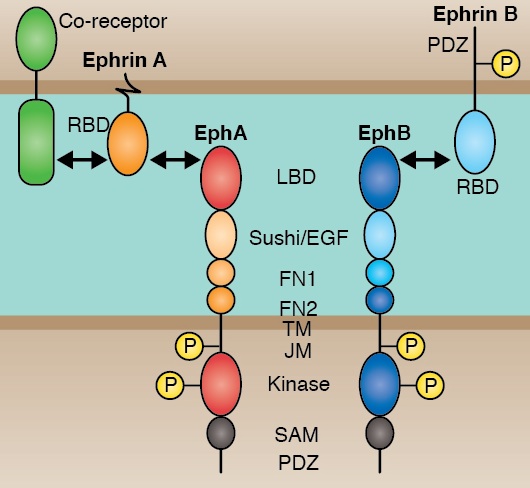 Eph receptors and their membrane-tethered ephrin ligands have important functions in development. Rudiger Klein provides an overview of the general structures and signalling mechanisms underlying Eph/ephrin signalling in development.
Eph receptors and their membrane-tethered ephrin ligands have important functions in development. Rudiger Klein provides an overview of the general structures and signalling mechanisms underlying Eph/ephrin signalling in development.
See the Development at a Glance poster article on p. 4105
In vitro organogenesis in three dimensions: self-organising stem cells
 Organ formation during embryogenesis is a complex process that involves various local cell-cell interactions at the molecular and mechanical levels. Yoshiki Sasai and colleagues discuss how, despite this complexity, organogenesis can be modelled in vitro using stem cells.
Organ formation during embryogenesis is a complex process that involves various local cell-cell interactions at the molecular and mechanical levels. Yoshiki Sasai and colleagues discuss how, despite this complexity, organogenesis can be modelled in vitro using stem cells.
See the Review on p. 4111
 (1 votes)
(1 votes)
 Loading...
Loading...


 (No Ratings Yet)
(No Ratings Yet)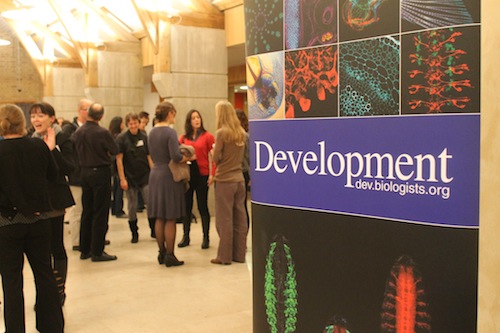
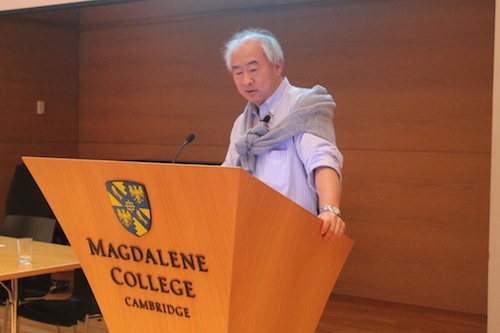
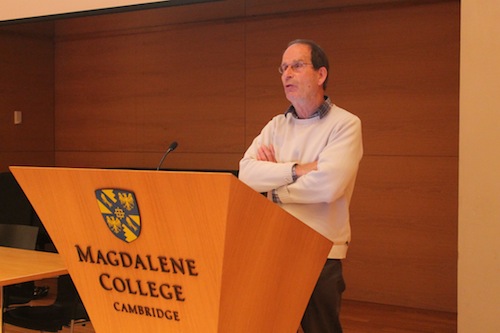
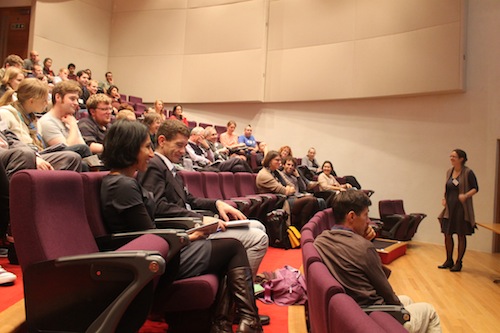

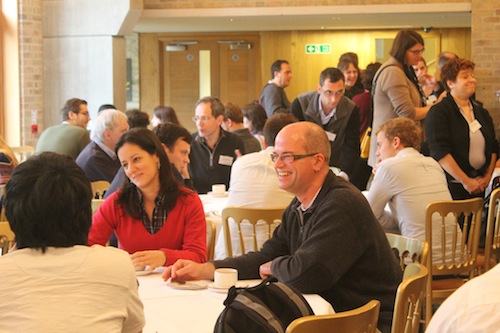
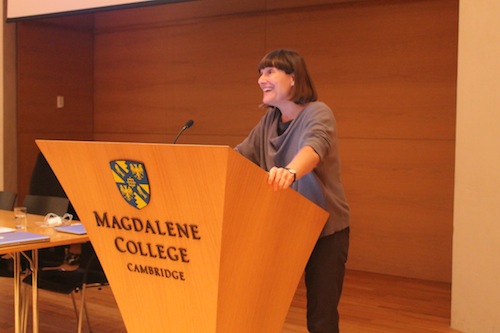
 (3 votes)
(3 votes)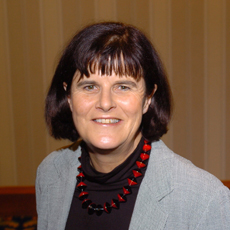 What made you decide to study the biology of ageing?
What made you decide to study the biology of ageing?
 To mark
To mark  (20 votes)
(20 votes) During mammalian gonadal development, somatic cues regulate the sex-specific development of foetal germ cells and control the transition between proliferation and cell-fate commitment. This transition is particularly important for male germ cells: too little proliferation reduces sperm numbers and fertility, whereas escape from commitment and prolonged pluripotency can cause testicular germ cell tumours. Now, Josephine Bowles, Peter Koopman and colleagues (p.
During mammalian gonadal development, somatic cues regulate the sex-specific development of foetal germ cells and control the transition between proliferation and cell-fate commitment. This transition is particularly important for male germ cells: too little proliferation reduces sperm numbers and fertility, whereas escape from commitment and prolonged pluripotency can cause testicular germ cell tumours. Now, Josephine Bowles, Peter Koopman and colleagues (p.  Unlike adult mammals, adult zebrafish can regenerate injured heart tissue. Heart regeneration in zebrafish is known to involve partial de-differentiation and proliferation of cardiomyocytes, but are cardiomyocytes involved in any other processes during heart repair? Here (p.
Unlike adult mammals, adult zebrafish can regenerate injured heart tissue. Heart regeneration in zebrafish is known to involve partial de-differentiation and proliferation of cardiomyocytes, but are cardiomyocytes involved in any other processes during heart repair? Here (p.  In amniote embryos, three kidneys – the pronephros (a transient embryonic structure), the mesonephros (the embryonic kidney) and the metanephros (the adult kidney) – form sequentially along the anterior-posterior (AP) axis of the intermediate mesoderm (IM). Here (p.
In amniote embryos, three kidneys – the pronephros (a transient embryonic structure), the mesonephros (the embryonic kidney) and the metanephros (the adult kidney) – form sequentially along the anterior-posterior (AP) axis of the intermediate mesoderm (IM). Here (p.  Polycomb group (PcG) genes encode transcriptional repressors that regulate gene expression during development. Most PcG genes encode subunits of chromatin-modifying complexes, but exactly how PcG proteins repress transcription is unclear. Now, Judith Kassis and colleagues report that Wapl, a cohesin-associated protein involved in cohesin removal from chromosomes, promotes PcG silencing in Drosophila (p.
Polycomb group (PcG) genes encode transcriptional repressors that regulate gene expression during development. Most PcG genes encode subunits of chromatin-modifying complexes, but exactly how PcG proteins repress transcription is unclear. Now, Judith Kassis and colleagues report that Wapl, a cohesin-associated protein involved in cohesin removal from chromosomes, promotes PcG silencing in Drosophila (p.  The skin protects the body from microbial pathogens by employing Toll-like receptors (TLRs) and other molecules that recognise pathogen-associated molecular patterns to initiate innate immune responses and to direct subsequent adaptive immunity. But when does the innate immune system in human skin become immunologically competent? On p.
The skin protects the body from microbial pathogens by employing Toll-like receptors (TLRs) and other molecules that recognise pathogen-associated molecular patterns to initiate innate immune responses and to direct subsequent adaptive immunity. But when does the innate immune system in human skin become immunologically competent? On p.  During sexual reproduction in flowering plants, cellular interactions guide the growth of the pollen tube from the stigma to the embryo sac where fertilisation occurs. The cytoplasmic Ca2+ concentration ([Ca2+]cyt) regulates pollen tube growth, but does it also regulate pollen tube guidance and reception? On p.
During sexual reproduction in flowering plants, cellular interactions guide the growth of the pollen tube from the stigma to the embryo sac where fertilisation occurs. The cytoplasmic Ca2+ concentration ([Ca2+]cyt) regulates pollen tube growth, but does it also regulate pollen tube guidance and reception? On p.  In 1991, John Bowman, David Smyth and Elliot Meyerowitz published a paper in Development that proposed the ABC model of flower development. Now, the authors look back on their paper and discuss several aspects of this story.
In 1991, John Bowman, David Smyth and Elliot Meyerowitz published a paper in Development that proposed the ABC model of flower development. Now, the authors look back on their paper and discuss several aspects of this story. In December 1996, in a special issue of Development, 37 papers reported the results of two large screens for zebrafish mutants performed in Tübingen and Boston. Now, Christiane Nüsslein-Volhard gives a personal account of the history of this unique endeavor.
In December 1996, in a special issue of Development, 37 papers reported the results of two large screens for zebrafish mutants performed in Tübingen and Boston. Now, Christiane Nüsslein-Volhard gives a personal account of the history of this unique endeavor. Eph receptors and their membrane-tethered ephrin ligands have important functions in development. Rudiger Klein provides an overview of the general structures and signalling mechanisms underlying Eph/ephrin signalling in development.
Eph receptors and their membrane-tethered ephrin ligands have important functions in development. Rudiger Klein provides an overview of the general structures and signalling mechanisms underlying Eph/ephrin signalling in development. Organ formation during embryogenesis is a complex process that involves various local cell-cell interactions at the molecular and mechanical levels. Yoshiki Sasai and colleagues discuss how, despite this complexity, organogenesis can be modelled in vitro using stem cells.
Organ formation during embryogenesis is a complex process that involves various local cell-cell interactions at the molecular and mechanical levels. Yoshiki Sasai and colleagues discuss how, despite this complexity, organogenesis can be modelled in vitro using stem cells. At the EMBO meeting last month, Jiří Friml was awarded the
At the EMBO meeting last month, Jiří Friml was awarded the